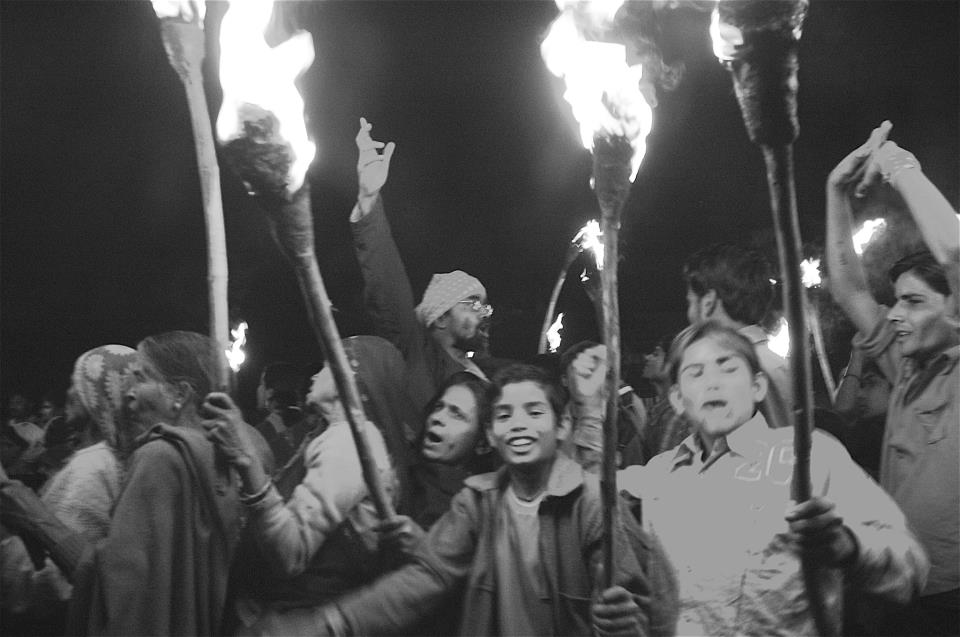After The Gas (Concluding part)
Sathyu Saranghi, tells the story of the first large, organised protest march, on3e month after the disaster, in condemnation of Union Carbide and demanding action form the Madhya Pradesh Government. He goes on to reflect on how he became involved in the struggle and remains there to this day.
March on the Chief Minister
During my third week in Bhopal, we began planning a march to Chief Minister Arjun Singh’s house. We decided to hold it on 3January 1985, a month after the disaster, which we would observe as Condemnation Day. It would be a chance to challenge the state government’s criminal neglect of the survivors, and to demand that it make arrangements for immediate health care for people suffering from eye damage, breathing problems, immune and neurological disorders, cardiac problems, injured lungs and the spate of difficult births.
As we moved from house to house, from one neighbourhood to the next, we found that the local people did not need much convincing – only desperate health problems could stop most of them joining the rally.
The march commenced with a few hundred people near the now-closed Union Carbide factory. As we went on, more and more groups of people holding hand-scrawled banners and chanting slogans joined the march. By the time we had covered half the distance (4 km) in about two hours, the march had swelled to over 10,000 people. Our procession was far from orderly – people were everywhere – traffic stood still. So many slogans were chanted by so many groups that it was impossible to hear any clearly; but what was very clear was that these cries came out of deep anger and despair.
People kept joining in waves, By the time we were climbing up the hill to the chief minister’s palatial & heavily guarded house, there were more than 15,000 survivors with us – far too many for the police to handle.
The Magic Protest
On arrival, we sought a meeting with the chief minister – it was not granted. We decided to sit on a dharna outside the minister’s residence. Thousands of voices vowed not to move until the chief minister agreed to our demands. Thus began one of my most memorable weeks in Bhopal. Among the rocks and bushes on the hillside outside the chief minister’s residence, people sat in small groups. Some began to look for wood to light fires, and teams set off to bring food. In the bastis, women breathless and choking more than usual from the smoky wood hearths were slapping dough for chapattis, not just for their own families but for strangers as well.
Families with little to give cared for orphaned children who had joined the dharna. Truck drivers slid quietly away from their delivery runs to fetch food and firewood and people from the shanties. Children found new friends to play with, and together they would chant the slogans they had begun to learn: ‘Dolaar kee chaal ne, zahar gholaa Bhopaal mein’ (Greed for dollars spews poison over Bhopal) and ‘Kaarbaaid ke khunee panje tod do mar do’ (Carbide’s bloodstained hands – strike them! break them!).
A few volunteer doctors tended to the sick, and there was always a team ready to carry people to the hospital.
Electricians rigged up wires from streetlights to power loudspeakers used for logistics and jokes and announcing the latest on the negotiations with Bhopal’s politicians and bureaucrats. Soon breathless poets were reciting poems of dignity and power; women who had rarely left their homes or showed their faces to strangers spoke of their anger against the foreign company and complicit government. I was happy to absorb this magic, all the bustling human activity, intense communication and, most of all, the powerful spirit of survival and cooperation. By the third day of our dharna, the government began to give way. Arjun Singh initially agreed to a meeting with a delegation of the leaders, but the mass insisted that he speak to all of them. At last he capitulated and came out before the vast crowd of survivors, thousands of whom poured into his residence to goggle at its fine rooms and opulent furnishings. People had learned that government could be made to listen to them.
No regrets
Thus began the three decades of my involvement with the survivors of the Bhopal gas leak. In early-1986, I left the ZGKSM (Poison Gas Disaster Struggle Committee) and founded the Bhopal Group for Information and Action. Given the intensely political nature of health issues, as exemplified by the sodium thiosulphate scandal (see Bhopal Marathon pp. 24-25), it was many years before we could set up the Sambhavna Trust. This was finally achieved in 1995 thanks to donations collected from concerned individuals by the newly set up Bhopal Medical Appeal. I can’t remember exactly when, but at some point during that week of dharna I decided to be part of this community of pain, suffering, sharing , joy and hope. Not once in the years since then have I regretted my decision.
Sathyu Sarangi is Managing Trustee of the Sambhavna Trust, which runs the free Sambhavna Trust Clinic in Bhopal.
You can read the complete Bhopal Marathon publication online here



